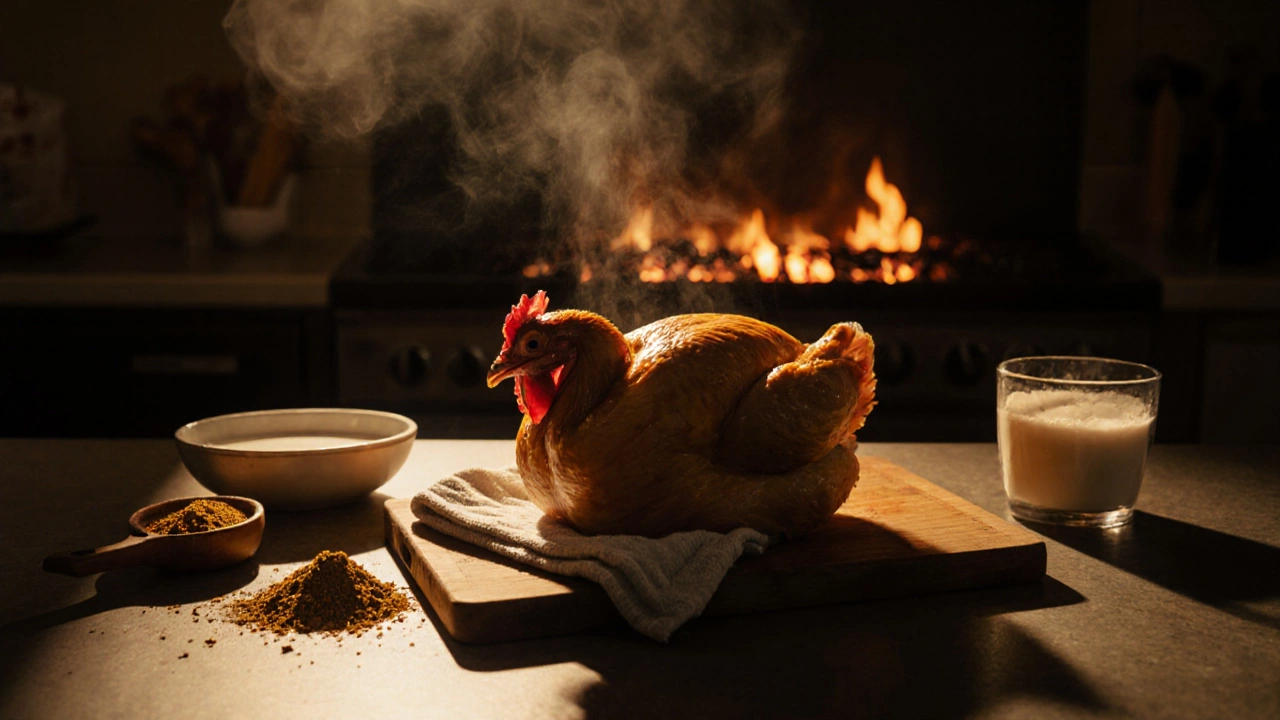Chicken Liquid Checker
Check Chicken Liquid Safety
The article explains that clear, odorless liquid from a chicken's mouth is usually normal mucus or crop fluid. This tool helps you determine if the liquid indicates a problem.
You’re prepping your chicken for the tandoori marinade when you notice it-clear, watery liquid dripping from its beak. Your stomach drops. Is this normal? Did something go wrong? Is the meat safe? You’re not alone. Every year, home cooks in New Zealand, India, and beyond panic over this exact sight. The truth? It’s rarely poison. More often, it’s a sign your chicken was stressed, sick, or just too cold.
It’s Not Secret Sauce-It’s Mucus or Crop Fluid
That liquid isn’t marinade. It’s not spice runoff. It’s biological fluid-either mucus from the respiratory tract or undigested food from the crop. Chickens don’t have saliva glands like humans. Their mouths produce thin, clear mucus to keep their airways moist. When they’re sick, stressed, or chilled, that mucus thickens and drips. It’s the same reason your nose runs when you catch a cold.
Another common source is the crop-the pouch in the chicken’s neck where food sits before digestion. If the chicken ate too fast, drank cold water, or had a blockage, the crop can overflow. You’ll see a watery, slightly sour-smelling liquid seep out. This isn’t blood. It’s not pus. It’s just food that didn’t move through properly.
When to Worry: Signs of Real Illness
Not every drip means disaster. But if the liquid is:
- Yellow, green, or bloody
- Thick and sticky like glue
- Accompanied by labored breathing, head shaking, or lethargy
- Coming from both mouth and nose
Then you’ve got something serious. These are signs of infectious diseases like avian influenza, fowl pox, or mycoplasmosis. These aren’t rare. In 2023, New Zealand’s Ministry for Primary Industries reported 17 outbreaks of avian flu in backyard flocks-mostly in the South Island. If your chicken is acting sick, don’t risk it. Isolate it. Call a vet. Don’t eat it.
But if the liquid is clear, odorless, and the chicken is still pecking at feed and flapping its wings? It’s probably just a reaction to cold weather or handling. Chickens in Wellington often get damp and chilly in autumn. A sudden drop from 22°C to 8°C can trigger mucus buildup. Same thing happens if you grabbed it roughly to pluck feathers.
Why This Happens Before Cooking
You’re not imagining this. It happens right before you start prepping. Why? Because stress triggers a physiological response. Chickens are prey animals. Being picked up, held upside down, or shoved into a transport crate? That’s terror. Their bodies go into survival mode. Blood flow shifts. Digestion stops. Mucus production spikes. That’s why you see the drip-right when you’re about to cook it.
It’s not a sign the chicken was rotten. It’s a sign it was scared. The same thing happens to turkeys at Thanksgiving, ducks at Chinese restaurants, and even the chickens you buy at the supermarket. If you’ve ever seen a store-bought chicken with a wet beak, now you know why.

What to Do Before Cooking
If the liquid is clear and the chicken looks otherwise healthy:
- Wipe the beak and chin gently with a clean, damp cloth.
- Let the chicken rest for 10-15 minutes in a warm, quiet space.
- Check for other signs: Are the eyes bright? Is the comb red? Is it standing normally?
- If all looks good, proceed with rinsing and marinating.
Don’t rinse the chicken under running water. That spreads bacteria. Just wipe it down. The real cleaning happens when you cook it to 74°C internally. That kills everything-even the bad bugs that might have been hiding.
Why Tandoori Chicken Is Still Safe
You’re making tandoori chicken. That means high heat. That means 250°C oven or charcoal grill. That means at least 20 minutes of direct, intense cooking. Even if there was a tiny bit of bacteria in that mucus, it’s gone. The yogurt, lemon, and spices in your marinade won’t kill germs-but the heat will.
People worry about raw chicken juice. But the liquid from the mouth? It’s not the same as gut contents or fecal contamination. It’s surface moisture. The real risk comes from cross-contamination-using the same knife for raw chicken and salad without washing it. That’s what you need to watch.

Prevention: Keep Your Chickens Calm and Warm
If you raise your own chickens, here’s how to reduce this in the future:
- Keep their coop dry and draft-free. Wet bedding = wet chickens = more mucus.
- Feed them warm water in cold weather. Cold water shocks their system.
- Handle them gently. Don’t grab by the legs. Support their body.
- Provide space. Overcrowding = stress = illness.
Chickens that are calm, warm, and well-fed rarely leak fluid from their mouths. If you see it often, it’s not the chicken’s fault. It’s your environment.
Myth: It’s Poison or Toxin
Some blogs claim this liquid is “toxic” or “chemical residue” from feed. That’s nonsense. Commercial chicken feed in New Zealand is regulated by MPI. It doesn’t contain toxins that leak from the beak. If it did, you’d see mass die-offs. You’d be reading headlines. You’re not. You’re just seeing a normal, if unsettling, biological response.
Same goes for “antibiotic residue.” Antibiotics are used sparingly in backyard flocks. Even if they were, they wouldn’t seep out as clear liquid. They’d be in the blood or liver-not the mouth.
Final Check: Is It Safe to Eat?
Here’s the simple rule:
- Clear, odorless liquid + active chicken = safe to cook.
- Colored, thick, or foul-smelling liquid + lethargic chicken = throw it out.
When in doubt, toss it. No tandoori marinade is worth your health. But if it’s just a little drip from a healthy bird? Wipe it off. Marinate it. Grill it hard. You’ll get juicy, flavorful chicken. And you’ll know exactly what that liquid was-and why it happened.

